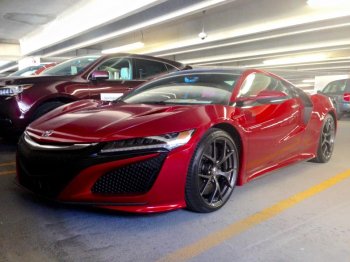When I first got my MG, my parts guy warned me that it was common that repairs I thought would be difficult/complicated often wouldn't be as bad as I expected, but that a seemingly simple repair could baffle you

.
The past two weeks have shown that to be the case. I absolutely dreaded installing the new exhaust, but it surprisingly easy-the most difficult part was getting the old loose(along with the corroded fasteners). Although I went with an OEM-style exhaust(which uses a two-box set up), I was quite pleased with it-it makes the noise of the car tolerable while still retaining the distinctive "British sports car" sound-especially the low frequency "grunt" on accelerating.
I started investigating and cleaning up what remained of my emissions system. I didn't think something was exactly "right" and though initially that the missing charcoal canister and requisite plumbing was causing a problem. The car(for the 1970 m/y and a few years around it) doesn't have a PCV valve, but instead uses vacuum lines off the carburetor to suck up and burn the crank case fumes. The problem is that when pulling air out of the crank case, you need a source of "make up" air, and I had no place from which to get that. If the car has a charcoal can, the make-up air comes from it into a vent in the top of the valve cover(the charcoal can also has the carb float bowls plumbed to it, along with the gas tank overflow/pressure relief to handle gasoline vapors). Before the charcoal can was used, the oil filler cap was ventilated to provide the make-up air(MGBs had some sort of PCV system from the beginning, with earlier and later ones having a PCV valve).
In any case, although I've seen 1970 cars with the charcoal can, it seems that was primarily a California thing. Since my car really shows no evidence of the can ever having been mounted(although screw holes are there) it likely never had a charcoal can. That means that the carb overflows go to the ground, the gas tank cap is ventilated, and the oil filler cap should be ventilated.
Someone on the MG Experience forum very generously sent me vented oil filler cap. I installed it this evening, and the engine seems much happier with it(I'd tried driving it previously with a rag rubber banded over the oil filler opening, and it made a similar difference). So, that's the emissions system complete-aside from the missing airpump(they're virtually impossible to find working, and don't really do a lot to reduce emissions on a correctly tuned car).
One would think that replacing an oil cap would be one of those "stupidly easy" jobs. The problem was that both caps have a retainer strap on them, and obviously I wanted to leave it in place. I had a terrible time getting the retainer strap off, and then getting the one for the replacement cap on. But, all sand and done, it was worth it.
Last week, another MG Experience member very generously gave me a Rostyle wheel with a(30 year old) tire on it. He is the president of the North American All-Register MG Council, and he was in Louisville for meetings for the big meet this summer. I'm debating if I want to install one of the 17 year old tires I took off the car, or if I should pay a local shop $50 for a used but reasonably new tire mounted and balanced on the rim. This is strictly as the spare, but obviously I want something that I could at least safely drive 50-100 miles or so on. Fortunately, I at least don't have tubes to deal with

I also bought a set of bonnet struts from the guy who gave me the wheel. I have yet to install the bonnet struts, but am really excited about them and am looking forward to getting them in place-no more getting the piece of PVC pipe out of the boot as a prop!
My "to do" list does continue to grow, however. I had trouble a couple of weeks back with a stuck needle valve in one of the carburetor bowls. I managed to limp home(fortunately I was just out for an evening drive, and I caught it after driving about a half mile and noticing something didn't seem right). I took that one apart the next day and cleaned it(it was fine), but also got my parts guy on the phone to order parts. I got new needle valves, seats, floats, and gaskets for both float bowls. The parts came in yesterday, but the weather has been crummy enough that I haven't driven it and thus haven't seen an immediate need to tackle it. I'll likely do that the start of next week. It did stick on me again on Tuesday, but I took my part's guys advice and hit it with a hammer-that cleared up the problem. I have a 10 oz. ball peen and a 4lb "BFH" in the boot, and both have been very convenient at times. This particular situation called for the 10 oz. hammer

I've been having clutch hydraulic issues for a while that I've kept at bay by just topping up the M/C reservoir every few weeks. Even so, I ordered a kit(master, slave, flex hose, and push rod) a few weeks ago and just haven't installed them yet. The slave should be easy since it bolts on the side of the transmission, but the master seems to be quite a bit more of a pain. There's a bolt retaining it that is only accessible from the interior side of the bulkead, and a nut holding it in place that's only accesible from the engine side of the bulkhead. I've read a lot of "tricks" on getting the one back in place, and hopefully one of them will work. I think I need to get right on it, though, as the M/C has started a slow fluid leak into the driver's footwell.











